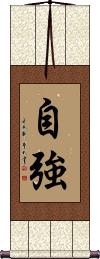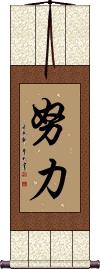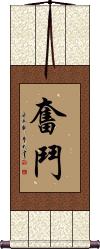Many custom options...
And formats...

Striving in Chinese / Japanese...
Buy a Striving calligraphy wall scroll here!
Personalize your custom “Striving” project by clicking the button next to your favorite “Striving” title below...
Always Striving for Inner Strength
自強不息 is a proverb or idiom that suggests that the pursuit of self-improvement is eternal. It can also be a suggestion to strive unremittingly in life.
The first two characters mean inner strength with the idea of self-improvement. The last two characters mean “never rest” or “striving without giving up.”
Some will translate these four characters as “Exert and strive hard without any let-up.”
Inner Strength / Self-Improvement
自強 is the kind of inner strength that applies to a person who has will-power and can inspire themselves to do great things.
自強 can also be the creed of a person that always pursues self-improvement.
Other translations: self-strengthening, striving for improvement, self-improvement, striving to become stronger, and self-renewal.
Great Endeavor / To Strive
努力 means great effort; to strive; to try hard; great effort; great exertion; great endeavor (endeavour); great effort; to strive.
This “striving endeavor” word is valid in Chinese, Japanese Kanji, and old Korean Hanja.
Seeking Truth
求道 means seeking for truth, or to seek (practice for, strive for) enlightenment.
求道 is used mostly in a Buddhist context, so some non-Buddhists may not recognize it.
Strive / Struggle
奮鬥 means strive (as in to put great effort into something or a cause).
It can also be translated as a struggle.
![]() The second character of this word can also be written as shown to the right. Yes.
it’s
very different. If you want this alternate version, just let us know when you place your order (in the special instructions).
The second character of this word can also be written as shown to the right. Yes.
it’s
very different. If you want this alternate version, just let us know when you place your order (in the special instructions).
Strive / Struggle
These search terms might be related to Striving:
A Truly Determined Person Will Find a Solution
Destiny Determined by Heaven
Go Kan Ryu
Go With the Flow
Go-Dan / 5th Degree Black Belt
Release / Let Go
Relentless / Ruthless
The Game of Weiqi / Weichi / Go
Unshakable / Determined
Wedding / Getting Married
Not the results for striving that you were looking for?
Below are some entries from our dictionary that may match your striving search...
| Characters If shown, 2nd row is Simp. Chinese |
Pronunciation Romanization |
Simple Dictionary Definition |
努力 see styles |
nǔ lì nu3 li4 nu li doryoku どりょく |
More info & calligraphy: Great Endeavor / To Strive(n,vs,vi) effort; exertion; endeavour; endeavor; hard work; striving; (surname) Nuriki to strive |
労 see styles |
láo lao2 lao rou / ro ろう |
Japanese variant of 勞|劳 labor; labour; toil; trouble; pains; work; effort; striving; (given name) Rou |
力求 see styles |
lì qiú li4 qiu2 li ch`iu li chiu |
to make every effort to; striving to do one's best |
勤行 see styles |
qín xíng qin2 xing2 ch`in hsing chin hsing gongyou / gongyo ごんぎょう |
(n,vs,vi) {Buddh} religious service Diligently going forward, zealous conduct, devoted to service, worship, etc. |
十心 see styles |
shí xīn shi2 xin1 shih hsin jisshin |
The ten kinds of heart or mind; there are three groups. One is from the 止觀 4, minds ignorant and dark; affected by evil companions; not following the good; doing evil in thought, word, deed; spreading evil abroad; unceasingly wicked; secret sin; open crime; utterly shameless; denying cause and effect (retribution)―all such must remain in the flow 流 of reincarnation. The second group (from the same book) is the 逆流 the mind striving against the stream of perpetual reincarnation; it shows itself in devout faith, shame (for sin), fear (of wrong-doing), repentance and confession, reform, bodhi (i.e. the bodhisattva mind), doing good, maintaining the right law, thinking on all the Buddhas, meditation on the void (or, the unreality of sin). The third is the 眞言 group from the 大日經疏 3; the "seed" heart (i.e. the original good desire), the sprout (under Buddhist religious influence), the bud, leaf, flower, fruit, its serviceableness; the child-heart, the discriminating heart, the heart of settled judgment (or resolve). |
大乘 see styles |
dà shèng da4 sheng4 ta sheng oonori おおのり |
Mahayana, the Great Vehicle; Buddhism based on the Mayahana sutras, as spread to Central Asia, China and beyond; also pr. [Da4 cheng2] (surname) Oonori Mahāyāna; also called 上乘; 妙乘; 勝乘; 無上乘; 無上上乘; 不惡乘; 無等乘, 無等等乘; 摩訶衍 The great yāna, wain, or conveyance, or the greater vehicle in comparison with the 小乘 Hīnayāna. It indicates universalism, or Salvation for all, for all are Buddha and will attain bodhi. It is the form of Buddhism prevalent in Tibet, Mongolia, China, Korea, Japan, and in other places in the Far East. It is also called Northern Buddhism. It is interpreted as 大教 the greater teaching as compared with 小教 the smaller, or inferior. Hīnayāna, which is undoubtedly nearer to the original teaching of the Buddha, is unfairly described as an endeavour to seek nirvana through an ash-covered body, an extinguished intellect, and solitariness; its followers are sravakas and pratyekabuddhas (i.e. those who are striving for their own deliverance through ascetic works). Mahāyāna, on the other hand, is described as seeking to find and extend all knowledge, and, in certain schools, to lead all to Buddhahood. It has a conception of an Eternal Buddha, or Buddhahood as Eternal (Adi-Buddha), but its especial doctrines are, inter alia, (a) the bodhisattvas 菩薩 , i.e. beings who deny themselves final Nirvana until, according to their vows, they have first saved all the living; (b) salvation by faith in, or invocation of the Buddhas or bodhisattvas; (c) Paradise as a nirvana of bliss in the company of Buddhas, bodhisattvas, saints, and believers. Hīnayāna is sometimes described as 自利 self-benefiting, and Mahāyāna as 自利利他 self-benefit for the benefit of others, unlimited altruism and pity being the theory of Mahāyāna. There is a further division into one-yana and three-yanas: the trīyāna may be śrāvaka, pratyeka-buddha, and bodhisattva, represented by a goat, deer, or bullock cart; the one-yāna is that represented by the Lotus School as the one doctrine of the Buddha, which had been variously taught by him according to the capacity of his hearers, v. 方便. Though Mahāyāna tendencies are seen in later forms of the older Buddhism, the foundation of Mahāyāna has been attributed to Nāgārjuna 龍樹. "The characteristics of this system are an excess of transcendental speculation tending to abstract nihilism, and the substitution of fanciful degrees of meditation and contemplation (v. Samādhi and Dhyāna) in place of the practical asceticism of the Hīnayāna school."[Eitel 68-9.] Two of its foundation books are the 起信論and the 妙法蓮華經 but a larnge numberof Mahāyāna sutras are ascribed to the Buddha。. |
常勤 see styles |
cháng qín chang2 qin2 ch`ang ch`in chang chin joukin / jokin じょうきん |
(n,vs,vi) full-time employment constant striving |
擺爛 摆烂 see styles |
bǎi làn bai3 lan4 pai lan |
(neologism c. 2014) (slang) to stop striving (esp. when one knows one cannot succeed); to let it all go to hell; (sports) to tank |
無諍 无诤 see styles |
wú zhēng wu2 zheng1 wu cheng mujō |
Without strife, debate, or contradiction; passionless; abiding in the 'empty' or spiritual life without debate, or without striving with others. |
研摩 see styles |
kenma けんま |
(noun/participle) (1) grinding; polishing; (2) refining (skill, knowledge, etc.); striving to master something |
研磨 see styles |
yán mó yan2 mo2 yen mo kenma けんま |
milling; to grind; to polish by grinding; to abrade; whetstone; pestle (noun/participle) (1) grinding; polishing; (2) refining (skill, knowledge, etc.); striving to master something; (surname) Kenma to grind |
要好 see styles |
yào hǎo yao4 hao3 yao hao |
to be on good terms; to be close friends; striving for self-improvement |
見諍 见诤 see styles |
jiàn zhēng jian4 zheng1 chien cheng kenjō |
Wrangling on behalf of heterodox views; striving to prove them. |
邁進 迈进 see styles |
mài jìn mai4 jin4 mai chin maishin まいしん |
to step in; to stride forward; to forge ahead (noun/participle) pushing forward (undaunted, bravely); working vigorously towards an aim; struggling on; striving towards |
まい進 see styles |
maishin まいしん |
(noun/participle) pushing forward (undaunted, bravely); working vigorously towards an aim; struggling on; striving towards |
我先に see styles |
waresakini われさきに |
(adverb) self first; striving to be first; scrambling for |
難行道 难行道 see styles |
nán xíng dào nan2 xing2 dao4 nan hsing tao nangyoudou / nangyodo なんぎょうどう |
{Buddh} (See 易行道) the hard way; striving for enlightenment through one's own efforts (as opposed to reliance on Amitabha) path of difficult practice |
一生精進 see styles |
isshoushoujin / isshoshojin いっしょうしょうじん |
(expression) {Buddh} striving to adopt ascetic practices for one's whole life |
希求品類 希求品类 see styles |
xī qiú pǐn lèi xi1 qiu2 pin3 lei4 hsi ch`iu p`in lei hsi chiu pin lei kegu honrui |
type of striving |
爭先恐後 争先恐后 see styles |
zhēng xiān kǒng hòu zheng1 xian1 kong3 hou4 cheng hsien k`ung hou cheng hsien kung hou |
striving to be first and fearing to be last (idiom); outdoing one another |
芝居っ気 see styles |
shibaikke しばいっけ |
(See 芝居気) striving for effect; heroics; dramatics; showmanship; staginess; (exaggerated) theatricality |
鞠躬盡力 鞠躬尽力 see styles |
jū gōng jìn lì ju1 gong1 jin4 li4 chü kung chin li |
to bend to a task and spare no effort (idiom); striving to the utmost; same as 鞠躬盡瘁|鞠躬尽瘁[ju1 gong1 jin4 cui4] |
鞠躬盡瘁 鞠躬尽瘁 see styles |
jū gōng jìn cuì ju1 gong1 jin4 cui4 chü kung chin ts`ui chü kung chin tsui |
to bend to a task and spare no effort (idiom); striving to the utmost |
Variations: |
maishin まいしん |
(n,vs,vi) pushing forward (undaunted, bravely); working vigorously towards an aim; struggling on; striving towards |
鞠躬盡瘁,死而後已 鞠躬尽瘁,死而后已 see styles |
jū gōng jìn cuì , sǐ ér hòu yǐ ju1 gong1 jin4 cui4 , si3 er2 hou4 yi3 chü kung chin ts`ui , ssu erh hou i chü kung chin tsui , ssu erh hou i |
to bend to a task and spare no effort unto one's dying day (idiom); striving to the utmost one's whole life; with every breath in one's body, unto one's dying day |
Variations: |
maishin まいしん |
(n,vs,vi) pushing forward (undaunted); pushing on (toward a goal); striving (for) |
Variations: |
waresakini われさきに |
(adverb) self first; striving to be first; scrambling for |
The following table may be helpful for those studying Chinese or Japanese...
| Title | Characters | Romaji (Romanized Japanese) | Various forms of Romanized Chinese | |
| Always Striving for Inner Strength | 自強不息 自强不息 | zì qiáng bú xī zi4 qiang2 bu2 xi1 zi qiang bu xi ziqiangbuxi | tzu ch`iang pu hsi tzuchiangpuhsi tzu chiang pu hsi |
|
| Inner Strength Self-Improvement | 自強 自强 | zì qiáng / zi4 qiang2 / zi qiang / ziqiang | tzu ch`iang / tzuchiang / tzu chiang | |
| Great Endeavor To Strive | 努力 | doryoku / doryoku | nǔ lì / nu3 li4 / nu li / nuli | |
| Seeking Truth | 求道 | gu dou / gudou / gu do | qiú dào / qiu2 dao4 / qiu dao / qiudao | ch`iu tao / chiutao / chiu tao |
| Strive Struggle | 奮鬥 / 奮斗 奋斗 / 奋鬥 | fèn dòu / fen4 dou4 / fen dou / fendou | fen tou / fentou | |
| Strive Struggle | 奮闘 / 奮鬥 奋斗 / 奋鬥 | fun tou / funtou / fun to | ||
| In some entries above you will see that characters have different versions above and below a line. In these cases, the characters above the line are Traditional Chinese, while the ones below are Simplified Chinese. | ||||
Successful Chinese Character and Japanese Kanji calligraphy searches within the last few hours...









